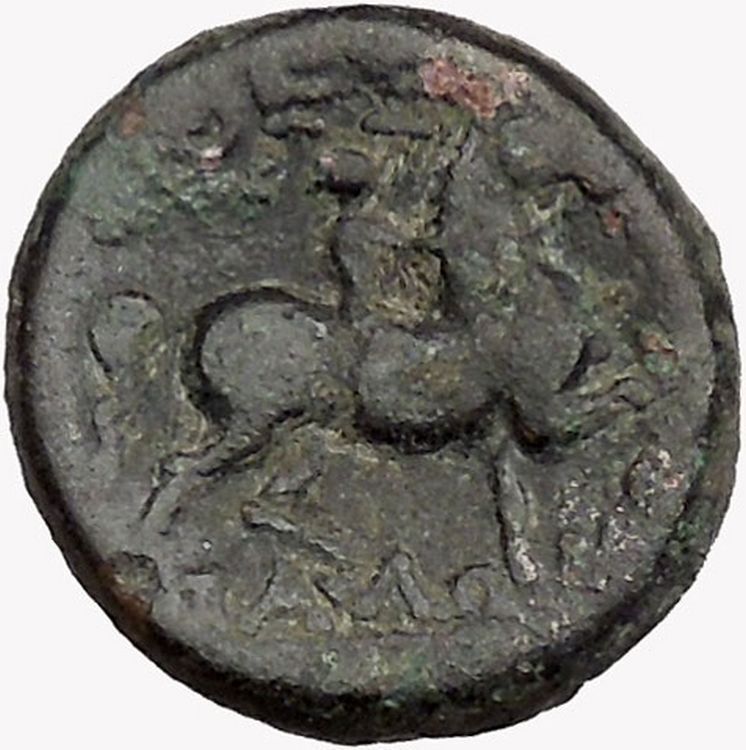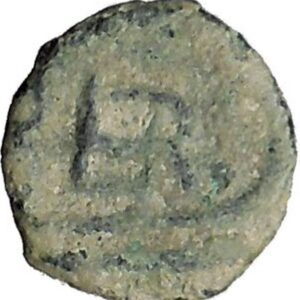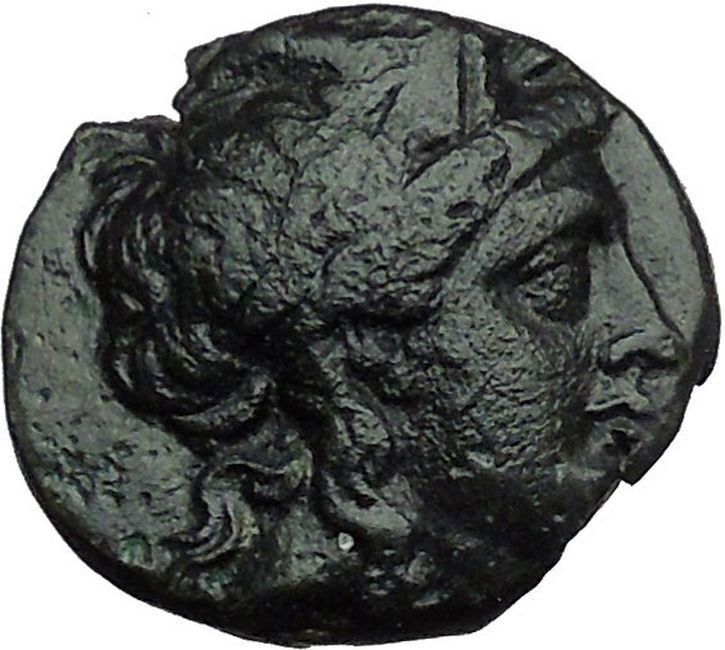|
Greek city of Kyzikos in Mysia
Bronze 7mm (0.70 grams) Struck circa 400-300 B.C.
Reference: Von Fritze III 2; SNG France 411; SNG Copenhagen 57
Laureate head of Apollo left.
KY / HI either side of amphora; below, tunny right.
Kyzikos (Cyzicus), one of the most ancient and powerful of the Greek cities in Asia Minor, stood upon an island of the same name in the Propontis (Sea of Marmara). This island, the earlier name of which was Arctonesus, lay close to the shore of Mysia, to which it was united by two bridges, and afterwards (under Alexander the Great) by a mole, which accumulated to a considerable isthmus. The city of Kyzikos stood on the south side of the island, at the north end of the isthmus, on each side of which it had a port. Tradition ascribed the foundation of the city to Doliones, a tribe of Thessalian Pelasgians, who had been driven from their homes by the Aeolians (people of Aeolis). It was said to have been afterwards colonized by Milesians. It was one of the finest cities of the ancient world, for the beauty of its situation and magnificence of its buildings: it possessed an extensive commerce, and was celebrated for the excellence of its laws and government. Its staters were among the most esteemed gold coins current in Greece. It took no conspicous place in history until about 22 years after the peace of Antalcidas, which it made itself independent of the Achaemenid empire. It preserved its freedom under Alexander and his successors, and was in alliance with the kings of Pergamon, and afterwards with the Romans. Its celebrated resistance against Mithradates the Great, when he besieged it by sea and land (B.C. 75), was of great service to the Romans, and obtained for it the rank of a “libera civitas,” which it lost again under Tiberius. Under Constantine the Great it became the chief city of the new province of Hellespontus. It was greatly injured by an earthquake in 443 A.D., and finally ruined by its conquest by the Arabians in 675.
You are bidding on the exact item pictured, provided with a Certificate of Authenticity and Lifetime Guarantee of Authenticity.
 In Greek and Roman mythology, Apollo, is one of the most important and diverse of the Olympian deities. The ideal of the kouros (a beardless youth), Apollo has been variously recognized as a god of light and the sun; truth and prophecy; archery; medicine and healing; music, poetry, and the arts; and more. Apollo is the son of Zeus and Leto, and has a twin sister, the chaste huntress Artemis. Apollo is known in Greek-influenced Etruscan mythology as Apulu. Apollo was worshiped in both ancient Greek and Roman religion, as well as in the modern Greco-Roman Neopaganism. In Greek and Roman mythology, Apollo, is one of the most important and diverse of the Olympian deities. The ideal of the kouros (a beardless youth), Apollo has been variously recognized as a god of light and the sun; truth and prophecy; archery; medicine and healing; music, poetry, and the arts; and more. Apollo is the son of Zeus and Leto, and has a twin sister, the chaste huntress Artemis. Apollo is known in Greek-influenced Etruscan mythology as Apulu. Apollo was worshiped in both ancient Greek and Roman religion, as well as in the modern Greco-Roman Neopaganism.
As the patron of Delphi (Pythian Apollo), Apollo was an oracular god – the prophetic deity of the Delphic Oracle. Medicine and healing were associated with Apollo, whether through the god himself or mediated through his son Asclepius, yet Apollo was also seen as a god who could bring ill-health and deadly plague as well as one who had the ability to cure. Amongst the god’s custodial charges, Apollo became associated with dominion over colonists, and as the patron defender of herds and flocks. As the leader of the Muses (Apollon Musagetes) and director of their choir, Apollo functioned as the patron god of music and poetry. Hermes created the lyre for him, and the instrument became a common attribute of Apollo. Hymns sung to Apollo were called paeans.
In Hellenistic times, especially during the third century BCE, as Apollo Helios he became identified among Greeks with Helios, god of the sun, and his sister Artemis similarly equated with Selene, goddess of the moon. In Latin texts, on the other hand, Joseph Fontenrose declared himself unable to find any conflation of Apollo with Sol among the Augustan poets of the first century, not even in the conjurations of Aeneas and Latinus in Aeneid XII (161-215). Apollo and Helios/Sol remained separate beings in literary and mythological texts until the third century CE.
 Cyzicus or Kyzikos was an ancient town of Mysia in Anatolia in the current Balıkesir Province of Turkey. It was located on the shoreward side of the present Kapıdağ Peninsula (the classical Arctonnesus), a tombolo which is said to have originally been an island in the Sea of Marmara only to be connected to the mainland in historic times either by artificial means or an earthquake. Cyzicus or Kyzikos was an ancient town of Mysia in Anatolia in the current Balıkesir Province of Turkey. It was located on the shoreward side of the present Kapıdağ Peninsula (the classical Arctonnesus), a tombolo which is said to have originally been an island in the Sea of Marmara only to be connected to the mainland in historic times either by artificial means or an earthquake.
The site of Cyzicus, located on the Erdek and Bandırma roads, is protected by Turkey’s Ministry of Culture.
History
See also: Siege of Cyzicus
The city was said to have been founded by Pelasgians from Thessaly, according to tradition at the coming of the Argonauts; later it received many colonies from Miletus, allegedly in 756 BC, but its importance began only after the Peloponnesian War, when the decay of Athens and Miletus set in. Alcibiades defeated the Lacedaemonians there (410 BC). Eudoxus of Cnidus had a school at Cyzicus and went with his pupils to Athens, visiting Plato, and then returned to Cyzicus, where he died 355 B.C. The era of Olympiads in Cyzicus was reckoned from 135 or 139.
Owing to its advantageous position it speedily acquired commercial importance, and the gold staters of Cyzicus were a staple currency in the ancient world till they were superseded by those of Philip of Macedon. Its unique and characteristic coin, the cyzicenus, was worth 28 drachmae.
During the Peloponnesian War (431-404 BC) Cyzicus was subject to the Athenians and Lacedaemonians alternately. In the naval Battle of Cyzicus in 410 during the Peloponnesian War, an Athenian fleet routed and completely destroyed a Spartan fleet. At the peace of Antalcidas (387 BC), like the other Greek cities in Asia, it was made over to Persia. Alexander the Great later captured it from the Persians in 334 BC and was later claimed to be responsible for the land bridge connecting the island to the mainland.
The history of the town in Hellenistic times is closely connected with that of the Attalids of Pergamon, with whose extinction it came into direct relations with Rome. Cyzicus was held for the Romans against King Mithridates VI of Pontus who besieged it with 300,000 men in 74 BC, but it withstood him stoutly, and the siege was raised by Lucullus: the loyalty of the city was rewarded by an extension of territory and other privileges. The Romans favored it and recognized its municipal independence. Cyzicus was the leading city of Northern Mysia as far as Troas.
Under Tiberius, it was incorporated into the Roman Empire but remained the capital of Mysia (afterwards, Hellespontus) and became one of the great cities of the ancient world.
Cyzicus was captured temporarily by the Arabs led by Muawiyah I in AD 675. It appears to have been ruined by a series of earthquakes beginning in 443, with the last in 1063. Although its population was transferred to Artake before the 13th century when the peninsula was occupied by the Crusaders, in 1324 the metropolitan of Cyzicus was one of three sees in Anatolia which was able to contribute a temporary annual subsidy to the Patriarchate of Constantinople. Following its conquest by the Ottomans it underwent hard times. From a point between 1370 and 1372 until 1387, the metropolitan was empty; Speros Vryonis speculates this was due to financial difficulties. Later in the 14th century, the sees of Chalcedon and certain patriarchal possessions in Bithynia and Hellespont were bestowed on the metropolitan of Cyzicus.
In the Ottoman era, it was part of the kaza of Erdek in the province of Brusa.
|





 In Greek and Roman mythology, Apollo, is one of the most important and diverse of the Olympian deities. The ideal of the kouros (a beardless youth), Apollo has been variously recognized as a god of light and the sun; truth and prophecy; archery; medicine and healing; music, poetry, and the arts; and more. Apollo is the son of Zeus and Leto, and has a twin sister, the chaste huntress Artemis. Apollo is known in Greek-influenced Etruscan mythology as Apulu. Apollo was worshiped in both ancient Greek and Roman religion, as well as in the modern Greco-Roman Neopaganism.
In Greek and Roman mythology, Apollo, is one of the most important and diverse of the Olympian deities. The ideal of the kouros (a beardless youth), Apollo has been variously recognized as a god of light and the sun; truth and prophecy; archery; medicine and healing; music, poetry, and the arts; and more. Apollo is the son of Zeus and Leto, and has a twin sister, the chaste huntress Artemis. Apollo is known in Greek-influenced Etruscan mythology as Apulu. Apollo was worshiped in both ancient Greek and Roman religion, as well as in the modern Greco-Roman Neopaganism. Cyzicus or Kyzikos was an ancient town of Mysia in Anatolia in the current Balıkesir Province of Turkey. It was located on the shoreward side of the present Kapıdağ Peninsula (the classical Arctonnesus), a tombolo which is said to have originally been an island in the Sea of Marmara only to be connected to the mainland in historic times either by artificial means or an earthquake.
Cyzicus or Kyzikos was an ancient town of Mysia in Anatolia in the current Balıkesir Province of Turkey. It was located on the shoreward side of the present Kapıdağ Peninsula (the classical Arctonnesus), a tombolo which is said to have originally been an island in the Sea of Marmara only to be connected to the mainland in historic times either by artificial means or an earthquake.




